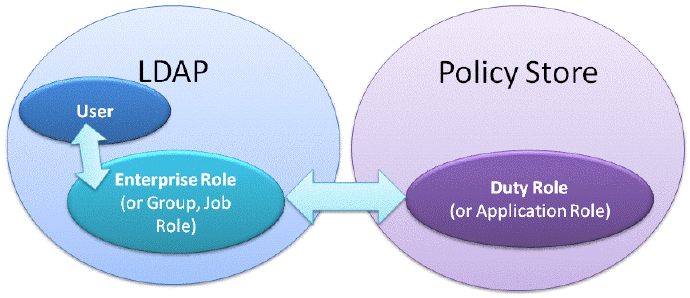1 Integrating Security for Oracle BI Applications
This chapter is aimed at security administrators, and explains how to set up and maintain security for Oracle Business Intelligence Applications.
This chapter contains the following topics:
1.1 Introduction
This section contains the following topics:
Section 1.1.1, "About Terminology Used In Security"
Section 1.1.2, "What Security Components Are Installed By Default?"
Section 1.1.3, "High Level Steps for Setting Up Security in Oracle BI Applications"
Section 1.1.4, "What Tools Configure Security in Oracle Business Intelligence Applications?"
Section 1.1.5, "What Security Levels Does Oracle BI Applications Use?"
Section 1.1.6, "Managing Duty Roles in Oracle BI Applications"
Section 1.1.7, "About Provisioning BI End Users"
1.1.1 About Terminology Used In Security
As you familiarize yourself with security concepts across different parts of the BI stack, note the following differences in terminology that are used in software and documentation.
-
Enterprise Roles are also referred to as Groups, or Job Roles. For example:
- the term Enterprise Role is used in this guide, and in Fusion Applications.
- the term Group is used in Oracle WebLogic Server Administration Console and Oracle BI Administration Tool.
This guide uses the term Enterprise Role unless referring to tools that use the term Group or Job Role.
-
Duty Roles are also referred to as Application Roles. For example:
- the term Duty Role is used in this guide and in Fusion Applications.
- the term Application Role is used in Oracle Enterprise Manager Fusion Middleware Control and Oracle Weblogic Server Administration Console.
This guide uses the term Duty Role unless referring to tools that use the term Application Role.
-
Lightweight Directory Access Protocol (LDAP) refers to the Authentication Provider. For example, Oracle WebLogic Server, Oracle Internet Directory (OID), or a proprietary LDAP server and tools.
1.1.2 What Security Components Are Installed By Default?
After installing Oracle BI Applications on the Oracle BI EE platform, you get the following ready-to-use security components (as described in Figure 1-2):
-
Oracle WebLogic Server LDAP, containing a set of default Enterprise Roles.
This LDAP also contains system Users that are required for BI components.
-
A Policy Store that contains default Duty Roles for all of the Offerings, Functional Areas, and Modules that are available in Oracle BI Applications.
Using the Default Weblogic Server LDAP and Policy Store
This guide explains how to use the default WebLogic Server LDAP and Policy Store to deploy Oracle BI Applications. For example, you might use the default security components for testing, and then migrate the Users and Enterprise Roles to a different LDAP (for example, Oracle Internet Directory) for production.
Using a Different LDAP and/or Policy Store
If you to deploy a different LDAP, such as Oracle Internet Directory, then you can migrate Users and Enterprise Roles from WebLogic Server LDAP to that LDAP.
1.1.3 High Level Steps for Setting Up Security in Oracle BI Applications
To set up security in Oracle BI Applications, you must do the following:
-
Read the rest of Section 1.1, 'Introduction' to get an overview of security concepts, tools, and terminology.
In particular, familiarize yourself with Duty Roles and how they control user privileges by reading Section 1.1.6, "Managing Duty Roles in Oracle BI Applications" and Section A.1.13, "How to Define New Groups and Mappings for Users and BI Roles".
Note: This content in this guide supplements Oracle Business Intelligence Security Guide, and contains additional security information that is specific to Oracle BI Applications running on Oracle Business Intelligence Enterprise Edition.
-
During Oracle BI Applications installation, the provisioning process creates a set of default Enterprise Roles in the Oracle WebLogic Server LDAP that is embedded by default, and a set of default Duty Roles in the Policy Store.
-
Create a user account in LDAP for each Oracle BI Applications Configuration Manager, Functional Setup Manager (FSM), and ODI User, and assign an appropriate Duty Role to each User.
For information about which Duty Roles to use, see Section 1.4.1, "Security Overview of Oracle BI Applications Configuration Manager and Functional Setup Manager".
For example:
- A User for administration in FSM must be assigned to an Enterprise Role associated with the Duty Role 'BIA_ADMINISTRATOR_DUTY'.
- A User for Load Plan administration in Oracle BI Applications Configuration Manager must be assigned to an Enterprise Role associated with the Duty Role 'BIA_LOAD_PLAN_DEVELOPER_DUTY'.
- A User for Implementation Plan administration in FSM must be assigned to an Enterprise Role associated with the Duty Role 'BIA_IMPLEMENTATION_MANAGER_DUTY'.
-
Create a user account in LDAP for every BI dashboard and report user (BI Users).
-
Assign each BI User to the appropriate Enterprise Roles.
To provision BI Users for the Offerings that you are deploying, use Functional Setup Manager (FSM) Tasks to set up security for your Offerings and Functional Areas. For information about using FSM Tasks to configure security, see Section 1.2, "Using Oracle BI Applications Functional Setup Manager Informational Tasks to Set Up Security".
For each Offering and Functional Area, the FSM Tasks for security typically specify:
- Init Blocks that you need to enable.
- Duty Roles that BI Users require.
- Additional setup steps to perform (where required).
In addition to the information in the FSM Tasks for security, use Content Guide for Oracle BI Applications for a definitive list of default Duty Roles and Enterprise Roles required by BI Users (refer to Tech Note 1639479.1 on My Oracle Support).
For more information about provisioning BI Users, refer to the following:
-
If you are using FMW provisioning, then refer to Section A.1.13.1, "How to Use Fusion Middleware (FMW) to Provision a BI User", as follows:
- If you are using the default Oracle WebLogic Server LDAP, then assign each BI User to the appropriate Enterprise Role for the Duty Role that the BI User requires, as described in Section A.1.13.1.1, "How to provision BI Users in the installed Oracle Weblogic Server LDAP".
- If you are using your own LDAP, then:
- if required, transfer the default Enterprise Roles from Oracle WebLogic Server LDAP to your LDAP.
- assign each BI User to an appropriate Enterprise Role, and make sure that this Enterprise Role is associated with the Duty Role that the BI User requires, as described in Section A.1.13.1.2, "How to provision BI Users using your own LDAP".
-
If you are using RPD Initialization Blocks for provisioning, then refer to Section A.1.13.2, "How to Use An RPD Init Block to Provision a BI User".
-
1.1.4 What Tools Configure Security in Oracle Business Intelligence Applications?
You use the following tools to manage security settings in Oracle Business Intelligence Applications:
-
Oracle BI Applications Functional Setup Manager (FSM)
Use Oracle BI Applications Functional Setup Manager informational tasks to set up security for Oracle BI Applications offerings and modules.
For a summary of how FSM Tasks are used to configure security, see Section 1.2, "Using Oracle BI Applications Functional Setup Manager Informational Tasks to Set Up Security".
-
Use Oracle BI Administration Tool to perform tasks such as setting permissions for business models, tables, columns, and subject areas; specifying filters to limit data accessibility; and setting authentication options. For detailed information, see Oracle Fusion Middleware Metadata Repository Builder's Guide for Oracle Business Intelligence Enterprise Edition.
-
Oracle BI Presentation Services Administration
Use Oracle BI Presentation Services Administration to perform tasks such as setting permissions to Presentation Catalog objects, including dashboards and dashboard pages. For detailed information, see Oracle Fusion Middleware Security Guide for Oracle Business Intelligence Enterprise Edition.
-
Oracle Enterprise Manager Fusion Middleware Control
Use Fusion Middleware Control to manage the policy store, Duty Roles, and permissions for determining functional access. For detailed information, see Oracle Fusion Middleware Security Guide for Oracle Business Intelligence Enterprise Edition.
-
Oracle WebLogic Server Administration Console
Use the Administration Console to manage Users and Enterprise Roles/Groups in the Oracle WebLogic Server LDAP. You can also use the Administration Console to manage security realms, and to configure alternative authentication providers. For detailed information, see Oracle Fusion Middleware Security Guide for Oracle Business Intelligence Enterprise Edition.
1.1.5 What Security Levels Does Oracle BI Applications Use?
Security in Oracle BI Applications can be classified broadly into the following three levels:
-
Object-level security. Object-level security controls the visibility to business logical objects based on a user's role. You can set up object-level security for metadata repository objects, such as business models and subject areas, and for Web objects, such as dashboards and dashboard pages, which are defined in the Presentation Catalog. For more information, see Section 1.4.5, "About Object-Level Security."
-
Data-level security. Data-level security controls the visibility of data (content rendered in subject areas, dashboards, Oracle BI Answers, and so on) based on the user's association to data in the transactional system. For more information, see Section 1.4.6, "About Data-Level Security."
-
User-level security (authentication of users). User-level security refers to authentication and confirmation of the identity of a user based on the credentials provided. For more information, see Section 1.4.7, "About User-Level Security."
1.1.6 Managing Duty Roles in Oracle BI Applications
Object-level and data-level security are implemented in Oracle BI Applications using Duty Roles in the Policy Store. Duty Roles define a set of permissions granted typically to an Enterprise Role.
Figure 1-3 illustrates how Users are assigned to Enterprise Roles in the LDAP, which are associated with Duty Roles in the Policy Store.
Duty Roles are typically related to either data or object security. For example, the Oracle BI Applications repository (OracleBIAnalyticsApps.rpd) uses the following Duty Roles:
-
The HR Org-based Security Duty Role is used to control access to human resources data at the data security level.
-
The Human Resources Analyst Duty Role is used to control Presentation layer object visibility for the Human Resources Analyst role at the object security level.
You can use a number of BI tools to view pre-configured Duty Roles, as follows:
-
Oracle BI Administration Tool
To view pre-configured Duty Roles using Oracle BI Administration Tool, open the RPD, select Manage, then select Identity. Duty Roles are visible in the Identity Manager dialog in online mode. In offline mode, only Duty Roles that have had permissions, filters, or query limits set for them appear. For this reason, it is recommended that when you work with data access security in the Oracle BI Applications repository, you use online mode.
-
Oracle Enterprise Manager Fusion Middleware Control - for details, see Section 1.1.6.1, "How to View Duty Roles for Oracle BI Applications".
-
Oracle Authorization Policy Manager - In Oracle APM, navigate to the 'obi' Application and use the Search options to locate Duty Roles prefixed with 'OBIA_'. Select a Duty Role, then click Open to display the <Application> | Application Role dialog. Display the External Role Mapping tab, and check that the role list contains the appropriate Enterprise Roles.
The standard hierarchical structure of Duty Roles and users in Oracle BI Applications is typically the following: data security Duty Role, then object security Duty Role, then Enterprise Role (also called Group), then User. It is a best practice to use this structure when setting up security.
Security administrators can view, modify, and create Duty Roles in Oracle Enterprise Manager Fusion Middleware Control.
For example, BI User Fred has Enterprise Role 'Fixed Asset Accounting Manager EBS'. To provision Fred with security access for Fixed Assets Accounting reporting for EBS, you edit the BI Duty Role 'Fixed Asset Accounting Manager EBS' and add Enterprise Role 'Fixed Asset Accounting Manager EBS' as a Member.
1.1.6.1 How to View Duty Roles for Oracle BI Applications
To view Duty Roles:
-
Log in to Oracle Enterprise Manager Fusion Middleware Control as an administrator.
-
Expand Business Intelligence, right-click coreapplication, and select Security, then Application Roles.
The available Duty Roles are listed. The Membership for <Duty Role name> area displays Enterprise Roles or other Duty Roles that are associated with the selected Duty Role.
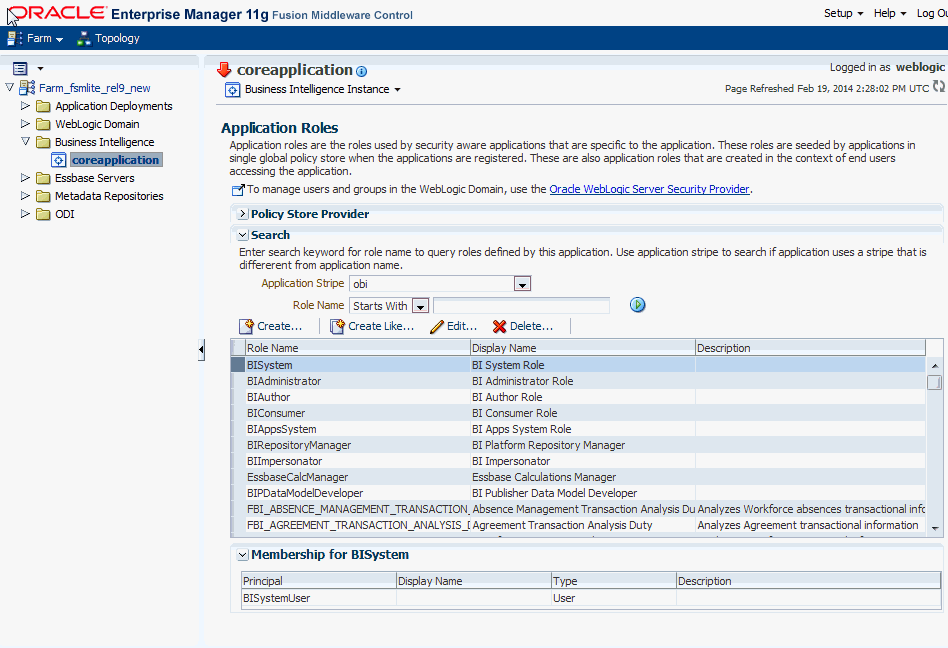
The screenshot below shows an example of additional pre-defined Duty Roles that are created when Oracle BI Applications is installed. The list of Duty Roles depends on your installation.
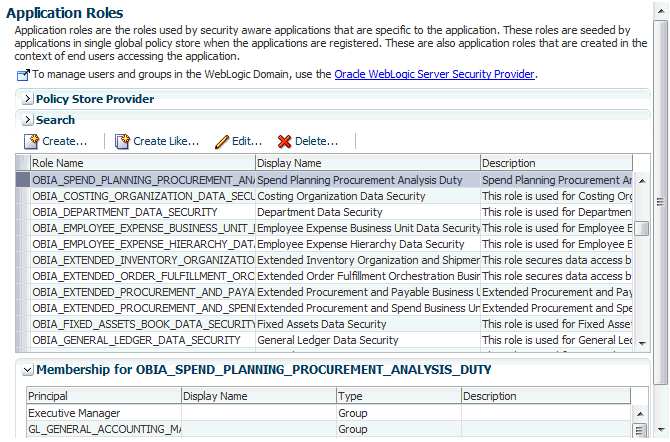
1.1.6.2 How to Provision BI Users with Duty Roles
To provision a BI User with a Duty Role, you first assign the User to an Enterprise Role/Group in LDAP, then make sure that the Enterprise Role/Group is associated with the appropriate Duty Role in the Policy Store.
If you are using the default embedded Enterprise Roles in Oracle WebLogic Server LDAP, then these Enterprise Roles are associated with the appropriate Duty Roles by default, and no further configuration is required.
If you are using a different LDAP with your own set of Enterprise Roles, then you need to make sure that these are associated with the appropriate Duty Roles, by following the steps below.
To provision BI Users with Duty Roles:
-
Log in to Oracle Enterprise Manager Fusion Middleware Control as an administrator.
-
Expand Business Intelligence, right-click coreapplication, and select Security, then Application Roles.
A list of available Duty Roles is displayed.

-
To provision a BI User with a Duty Role:
-
Select the Duty Role that a BI User requires access to.
-
Click Edit to display the Edit Application Role dialog.
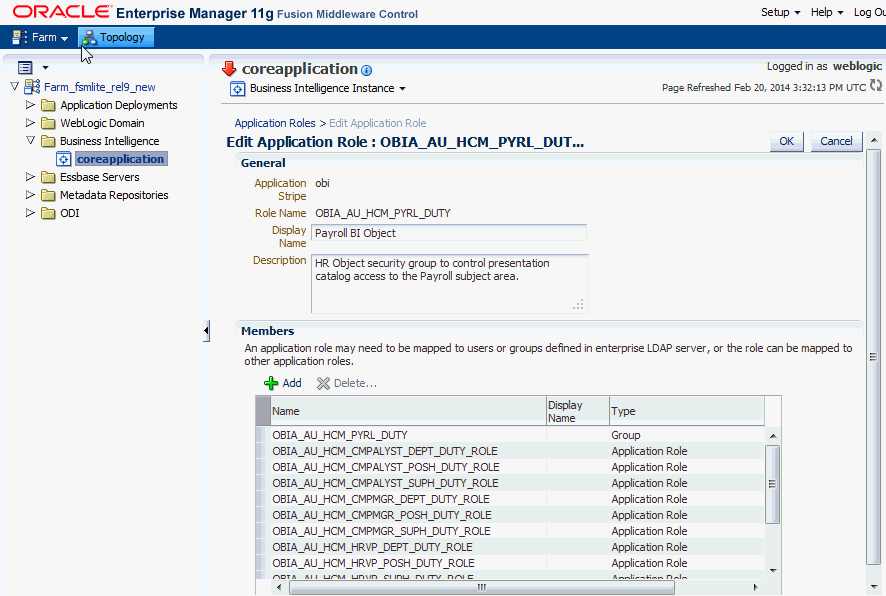
-
In the Member list, click Add to display the Add Principal dialog.
-
Use the Search area to locate and select the Enterprise Role/Group that the BI User has.
For example, User Fred has Enterprise Role 'Fixed Asset Accounting Manager EBS'. To provision Fred with security access for Fixed Assets Accounting reporting for EBS, you edit the BI Duty Role 'Fixed Asset Accounting Manager EBS' and add Enterprise Role 'Fixed Asset Accounting Manager EBS' as a Member.
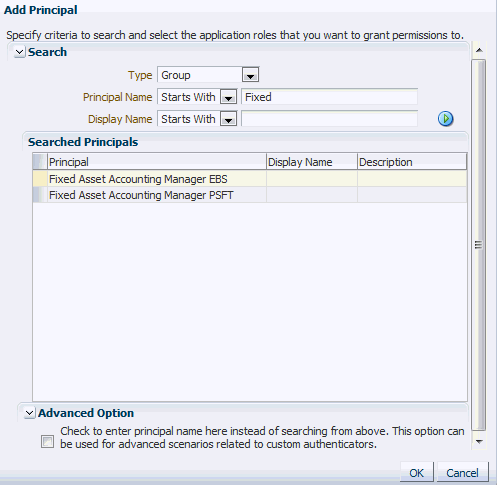
-
Click OK.
-
1.1.6.3 How to Edit or Create Duty Roles for Oracle BI Applications
-
Log in to Oracle Enterprise Manager Fusion Middleware Control as an administrator.
-
Expand Business Intelligence, right-click coreapplication, and select Security, then Application Roles.
A list of available Duty Roles is displayed.

-
To edit a Duty Role:
-
In the Application Roles list, select the Duty Role that you want to edit.
-
Click Edit...
-
Use the Edit Application Role dialog to change the details, then click OK.
-
-
To create a Duty Role:
-
Click Create... to display the Create Application Role dialog.
Alternatively, select a Duty Role similar to the one that you want to create, and click Create Like. Using Create Like copies the default Members (that is, Enterprise Roles/Groups).

-
Use the General area to specify the details.
-
In the Member list, click Add to search for and select the Enterprise Roles/Groups that you want this Duty Role to be associated with.
-
Click OK.
-
1.1.6.4 Authorizing User Access Using Roles
It is possible to grant multiple Duty Roles to a User; however Oracle recommends that Enterprise Roles are defined so that a User is provisioned with a single Duty Role.
If you have Oracle Business Intelligence Enterprise Edition test servers configured against a test LDAP, and the production servers are configured against the corporate LDAP, but the test LDAP is not a fan-out copy of the corporate LDAP directory, then you must refresh the LDAP GUIDs. See "Refreshing User GUIDs" in Oracle Fusion Middleware Security Guide for Oracle Business Intelligence Enterprise Edition for more information. Note that while LDAP is required for Fusion Applications environments, it is optional for other source applications.
1.1.7 About Provisioning BI End Users
BI Users are provisioned with BI Duty Roles using Enterprise Roles in the LDAP. To provision users, you typically use either Oracle Fusion Middleware, or RPD initialization blocks.
For more information about how to provision BI Users, see Section A.1.13, "How to Define New Groups and Mappings for Users and BI Roles".
1.2 Using Oracle BI Applications Functional Setup Manager Informational Tasks to Set Up Security
To set up security for Offerings in Oracle BI Applications, you use Functional Setup Manager (FSM) to manage the security tasks. When you create an Implementation Plan in FSM for a particular Functional Area, FSM provides a list of tasks required to configure that Functional Area, including security setup tasks. Security setup tasks typically have the word 'Security' in the task name.
Note: For detailed information about using FSM tasks, see Oracle Business Intelligence Applications Configuration Guide.
For example, the screenshot below shows a list of FSM Tasks for a Functional Area in Human Resources. A number of security-related tasks are highlighted, for example, 'How to Set Up Payroll Based Data Security'.
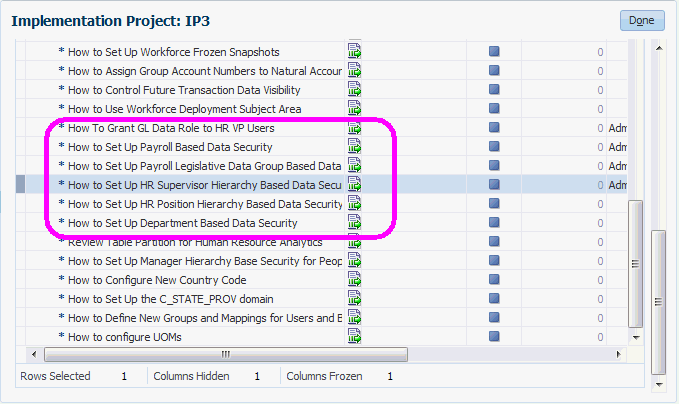
To configure security for a Functional Area:
-
Navigate to the Implementation Project that has been created to configure a Functional Area.
If you log in as an Administrator, then you have access to all FSM Tasks. If you log in as a Functional Developer, then the Assigned Implementation Tasks tab provides a list of FSM Tasks that have been assigned to you by the Administrator.
For example, the screenshot below shows a list of FSM Tasks for a Human Resources module with the Task named 'How to Setup Up HR Supervisor Hierarchy Based Data Security' selected.
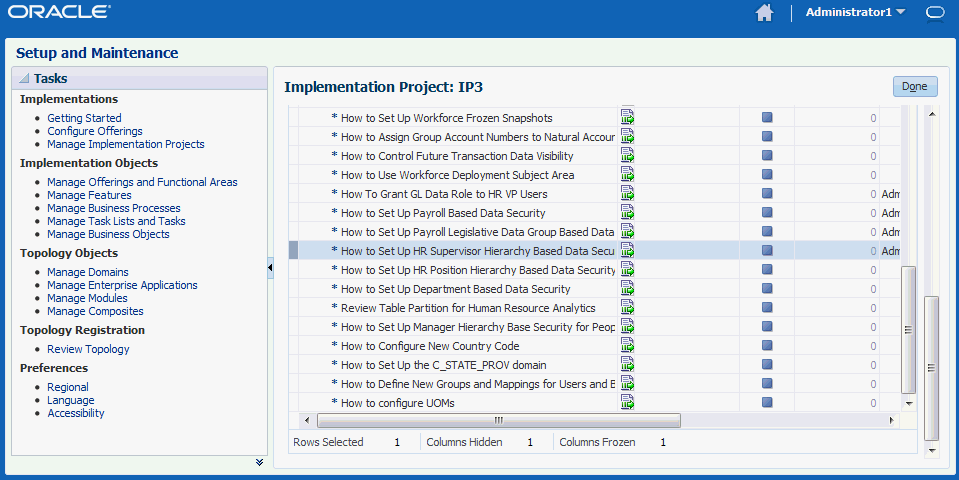
-
For each security task, do the following:
-
Click the Go to Task icon next to the security task.
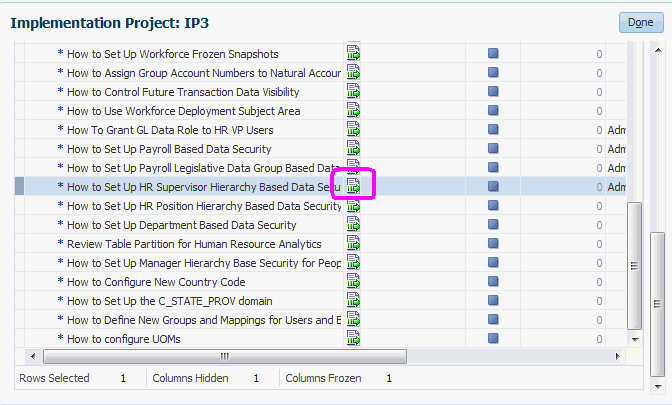
-
Click the Help icon next to the Task name.
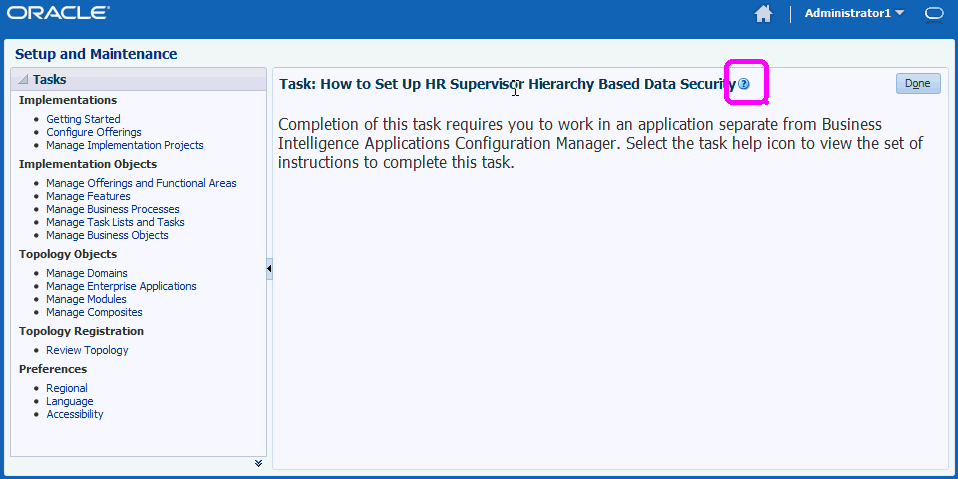
The instructions are displayed in a Help topic.

-
Follow the instructions in the Help topic.
To complete the task, you typically use one of the security tools such as Oracle Fusion Middleware Control, or Oracle BI Administration Tool.
For example, the steps might involve logging into Oracle WebLogic Server Administration Console to provision a set of users.
-
In FSM, click Done.
-
Set the status of the task to 'Completed'.
-
1.3 Extending Security in Oracle BI Applications
You can extend the preconfigured Oracle BI Applications security model to match your operational source system. When you extend Oracle BI Applications, you need to ensure that your customizations and any new objects are valid and functional.
The general process for extending data-level security for repository objects is as follows:
-
Extend the physical table by adding the attribute by which the dimension or fact needs to be secured. (This step results in a change to the data model.)
-
Populate the relevant attribute value for each row in the fact or dimension table. (This step results in a change to the ETL mapping.)
-
Use the Oracle BI Administration Tool to create an initialization block to fetch the attribute values and populate them into a session variable when each user logs into Oracle BI Applications. You can create a target session variable for the initialization block if the initialization block is not a row-wise initialization block. (This step results in a change to the Oracle BI repository.) For instructions, see Oracle Fusion Middleware Metadata Repository Builder's Guide for Oracle Business Intelligence Enterprise Edition.
-
Use Fusion Middleware Control to create a Duty Role in the policy store. Then, restart the Oracle BI Server. For instructions, see Oracle Fusion Middleware Security Guide for Oracle Business Intelligence Enterprise Edition.
-
Use the Oracle BI Administration Tool in online mode to set up data filters based on the new role for each of the fact and dimension tables that need to be secured by the attribute you added in Step 1. (This step results in a change to the Oracle BI Repository.) For instructions, see Oracle Fusion Middleware Metadata Repository Builder's Guide for Oracle Business Intelligence Enterprise Edition.
-
Use the Oracle BI Administration Tool in online mode to restrict object access based on the Duty Role you created in Step 4. (This step results in a change to the Oracle BI Repository.) For instructions, see Oracle Fusion Middleware Metadata Repository Builder's Guide for Oracle Business Intelligence Enterprise Edition.
-
Use Presentation Services administration to set up Presentation Services catalog privileges based on the Duty Role you created in step 4. For instructions, see Oracle Fusion Middleware Security Guide for Oracle Business Intelligence Enterprise Edition.
Note:
You can also leverage the existing Oracle BI Applications security objects when extending data-level security. To do this, copy existing security objects for secured dimensions, such as initialization blocks and Duty Roles, and then modify them to apply to the additional dimensions.
For more information on working with security objects like Duty Roles and initialization blocks, see the following resources:
-
"Creating and Managing Duty Roles and Application Policies Using Fusion Middleware Control" in Oracle Fusion Middleware Security Guide for Oracle Business Intelligence Enterprise Edition
-
"Working with Initialization Blocks" in Oracle Fusion Middleware Metadata Repository Builder's Guide for Oracle Business Intelligence Enterprise Edition
1.4 Supplementary Information About Security In Oracle BI Applications
This section contains supplementary and reference information about Oracle BI Applications Security, and contains the following sections:
Section 1.4.3, "Checking Oracle BI Applications User Responsibilities"
Section 1.4.5, "About Object-Level Security"
Section 1.4.6, "About Data-Level Security"
Section 1.4.7, "About User-Level Security"
Section 1.4.8, "Additional Sources of Information About Oracle BI Applications Security"
1.4.1 Security Overview of Oracle BI Applications Configuration Manager and Functional Setup Manager
To access Oracle BI Applications Configuration Manager or Functional Setup Manager (for Oracle BI Applications), a User must be assigned to an Enterprise Role that is associated with one of the following Duty Roles:
-
BI Applications Administrator Duty (BIA_ADMINISTRATOR_DUTY)
Users with the BI Applications Administrator Duty Role have access to all Oracle BI Applications Configuration Manager User Interfaces and all Functional Setup Manager User Interfaces. For Oracle BI Applications Configuration Manager, only users with this Duty Role are able to perform system setup tasks.
-
BI Applications Implementation Manager (BIA_IMPLEMENTATION_MANAGER_DUTY)
Users with the BI Applications Implementation Manager Duty Role have access to Oracle BI Applications Configuration Manager Overview page and the Export and Import of Setup Data. In Functional Setup Manager, these users have access to Configure Offerings and Manage Implementation Projects User Interfaces but cannot execute a setup task.
-
BI Applications Functional Developer (BIA_FUNCTIONAL_DEVELOPER_DUTY)
Users with the BI Applications Functional Developer Duty Role have access to Oracle BI Applications Configuration Manager User Interfaces, except for the System Setup screens. In Functional Setup Manager, these users have access to the list of functional setup tasks assigned to them and have the ability to execute the setup tasks.
-
BI Applications Load Plan Developer (BIA_LOAD_PLAN_DEVELOPER_DUTY)
Users with the BI Applications Load Plan Developer Duty Role have access to the Load Plans page, where they can create, edit, delete, generate, execute and monitor load plans. Users with this role can view and edit fact groups, data load parameters, domains mappings, and schedules associated with a load plan.
-
BI Applications Load Plan Operator (BIA_LOAD_PLAN_OPERATORY_DUTY)
Users with the BI Applications Load Plan Operator Duty Role have limited access to the Load Plans page, where they can view the generation status and execution status details of load plans but are not able to modify them.
1.4.2 About Permissions in Oracle BI Applications Configuration Manager and Functional Setup Manager
This section describes permissions in Oracle BI Applications Configuration Manager and Functional Setup Manager, and contains the following sections.
-
Section 1.4.2.1, "About Permissions in Oracle BI Applications Configuration Manager"
-
Section 1.4.2.2, "About Permissions in Functional Setup Manager"
1.4.2.1 About Permissions in Oracle BI Applications Configuration Manager
Table 1-1 shows the list of Oracle BI Applications Configuration Manager screens visible to each of the Oracle BI Applications Roles.
Table 1-1 List of Oracle BI Applications Configuration Manager Screens Visible to Each Oracle BI Applications Duty Role
| Oracle BI Applications Duty Role | Oracle BI Applications Configuration Manager screen | Associated Privilege |
|---|---|---|
|
BI Applications Administrator |
Overview |
BIA_OVERVIEW_PRIV |
|
BI Applications Administrator |
System Setups - Define Oracle BI Applications Instance |
BIA_DEFINE_INSTANCE_PRIV |
|
BI Applications Administrator |
System Setups - Manage Oracle BI Applications |
BIA_MANAGE_INSTANCE_PRIV |
|
BI Applications Administrator |
System Setups - Manage Preferred Currencies |
BIA_MANAGE_INSTANCE_PRIV |
|
BI Applications Administrator |
Functional Configurations - 'Perform Functional Configurations' link to launch Functional Setup Manager |
BIA_FUNCTIONAL_SETUPS_PRIV |
|
BI Applications Administrator |
Setup Data Maintenance and Administration - Manage Domains and Mappings |
BIA_CONFIGURE_DOMAINS_PRIV |
|
BI Applications Administrator |
Setup Data Maintenance and Administration - Manage Data Load Parameters |
BIA_CONFIGURE_DATALOAD_PARAMS_PRIV |
|
BI Applications Administrator |
Setup Data Maintenance and Administration - Manage Reporting Parameters |
BIA_CONFIGURE_RPD_PARAMS_PRIV |
|
BI Applications Administrator |
Setup Data Export and Import - Export Setup Data |
BIA_EXPORT_SETUPS_PRIV |
|
BI Applications Administrator |
Setup Data Export and Import - Import Setup Data |
BIA_IMPORT_SETUPS_PRIV |
|
BI Applications Functional Developer |
Overview |
BIA_OVERVIEW_PRIV |
|
BI Applications Functional Developer |
Functional Configurations - 'Perform Functional Configurations' link to launch Functional Setup Manager |
BIA_FUNCTIONAL_SETUPS_PRIV |
|
BI Applications Functional Developer |
Setup Data Maintenance and Administration - Manage Domains and Mappings |
BIA_CONFIGURE_DOMAINS_PRIV |
|
BI Applications Functional Developer |
Setup Data Maintenance and Administration - Manage Data Load Parameters |
BIA_CONFIGURE_DATALOAD_PARAMS_PRIV |
|
BI Applications Functional Developer |
Setup Data Maintenance and Administration - Manage Reporting Parameters |
BIA_CONFIGURE_RPD_PARAMS_PRIV |
|
BI Applications Functional Developer |
Setup Data Export and Import - Export Setup Data |
BIA_EXPORT_SETUPS_PRIV |
|
BI Applications Functional Developer |
Setup Data Export and Import - Import Setup Data |
BIA_IMPORT_SETUPS_PRIV |
|
BI Applications Implementation Manager |
Overview |
BIA_OVERVIEW_PRIV |
|
BI Applications Implementation Manager |
Setup Data Export and Import - Export Setup Data |
BIA_EXPORT_SETUPS_PRIV |
|
BI Applications Implementation Manager |
Setup Data Export and Import - Import Setup Data |
BIA_IMPORT_SETUPS_PRIV |
1.4.2.2 About Permissions in Functional Setup Manager
Functional Setup Manager Roles are associated with Oracle BI Applications Roles as follows:
-
The BI Applications Administrator role (BIA_ADMINISTRATOR_DUTY) is associated to the following Functional Setup Manager Roles:
-
ASM_FUNCTIONAL_SETUPS_DUTY
-
ASM_IMPLEMENTATION_MANAGER_DUTY
-
ASM_APPLICATION_DEPLOYER_DUTY
-
ASM_APPLICATION_REGISTRATION_DUTY
-
ASM_LOGICAL_ ENTITY_MODELING_DUTY
-
ASM_SETUP_OBJECTS_PROVIDER_DUTY
-
-
The BI Applications Implementation Manager role (BIA_IMPLEMENTATION_MANAGER_DUTY) is associated to the following Functional Setup Manager duty:
-
ASM_IMPLEMENTATION_MANAGER_DUTY
-
-
The BI Applications Functional Developer role (BIA_FUNCTIONAL_DEVELOPER_DUTY) is associated to the following Functional Setup Manager duty:
-
ASM_FUNCTIONAL_SETUPS_DUTY
-
1.4.3 Checking Oracle BI Applications User Responsibilities
Pre-configured Duty Roles match responsibilities and roles in source operational applications, so that after authentication the correct roles can be applied. An administrator can check a user's responsibilities in the following ways:
-
In the Siebel or Oracle EBS operational applications, go to the Responsibilities view.
-
In PeopleSoft applications, go to the Roles view to check a user's roles.
-
In JD Edwards EnterpriseOne applications, go to the User Profiles application (P0092) to check a user's roles.
-
Individual users can view the list of Duty Roles to which they are assigned. In the Oracle BI application, click Signed In As username and select My Account. Then, click the Roles and Catalog Groups tab to view the Duty Roles. In Presentation Services, Duty Roles are used to control the ability to perform actions (privileges) within Presentation Services.
For more information, refer to the system administrator for your source system.
1.4.4 About Managing Presentation Services Catalog Privileges in Oracle Business Intelligence
When you add a new catalog privilege to a Duty Role in Oracle BI Presentation Services, the change is not immediately reflected in the Oracle Business Intelligence environment. In order to register the catalog privilege, both the administrator and the user must perform the following tasks:
-
The Oracle BI administrator must reload the Oracle BI Server metadata through Oracle BI Presentation Services. To reload the metadata, in Oracle Business Intelligence Answers, select Administration, and then click Reload Files and Metadata.
For more information on managing Presentation Services catalog privileges, see Oracle Fusion Middleware Security Guide for Oracle Business Intelligence Enterprise Edition.
-
Users belonging to that Duty Role must log out from the Oracle BI application (or from Siebel or Oracle EBS operational application if the user is looking at Oracle BI dashboards using an embedded application) and then log in again.
1.4.5 About Object-Level Security
This section describes the object-level security features in Oracle BI Applications. It contains the following topics:
-
Section 1.4.5.1, "Metadata Object-Level Security in the RPD"
-
Section 1.4.5.2, "Metadata Object-Level Security in Presentation Services"
1.4.5.1 Metadata Object-Level Security in the RPD
Duty Roles control access to metadata objects, such as subject areas, tables and columns. For example, users in a particular department can view only the subject areas that belong to their department.
Metadata object security is configured in the Oracle BI Repository, using the Oracle BI Administration Tool. The Everyone Duty Role is denied access to each of the subject areas. Each subject area is configured to give explicit read access to selected related responsibilities. This access can be extended to tables and columns.
Note:
By default in Oracle BI Applications, only permissions at the subject area level have been configured.
Note:
The Siebel Communications and Financial Analytics industry applications have tables and columns that are industry-specific, and, therefore, hidden from other Duty Roles.
Oracle Business Intelligence supports hierarchies within Duty Roles. In the policy store, there are certain Duty Roles that are parent Duty Roles, which define the behavior of all the child Duty Roles. Inheritance is used to enable permissions to ripple through to child Duty Roles. For more information about parent Duty Roles and the pre-built Duty Role hierarchies, refer to the list of groups, Duty Roles, initialization blocks, and security policies published on My Oracle Support as a document named 'Oracle Business Intelligence Applications Roles and Security'.
1.4.5.2 Metadata Object-Level Security in Presentation Services
Access to Oracle BI Presentation Services objects, such as dashboards, pages, reports, and Web folders, is controlled using Duty Roles. For detailed information about managing object-level security in Presentation Services, see Oracle Fusion Middleware Security Guide for Oracle Business Intelligence Enterprise Edition.
1.4.6 About Data-Level Security
This section describes the data-level security features in Oracle BI Applications. It contains the following topics:
-
Section 1.4.6.1, "Overview of Data-Level Security in Oracle BI Applications"
-
Section 1.4.6.2, "Implementing Data-Level Security in the Oracle BI Repository"
-
Section 1.4.6.3, "Initialization Blocks Used for Data-Level Security in Oracle BI Applications"
-
Section 1.4.6.4, "About Data-Level Security Design in Oracle BI Applications"
1.4.6.1 Overview of Data-Level Security in Oracle BI Applications
Data-level security defines what a user in an OLTP application can access inside a report. The same report, when run by two different users, can bring up different data. This is similar to how the My Opportunities view in an operational application displays different data for different users. However, the structure of the report is the same for all users, unless a user does not have access to the report subject area, in which case the report displays an error.
For information about the data security policies that are supported in Oracle BI Applications, refer to the list published on My Oracle Support as a document named 'Oracle Business Intelligence Applications Roles and Security'. During installation and configuration, you must make sure the correct Duty Roles and initialization blocks are set up for your environment.
For more information about the use of initialization blocks in Oracle Business Intelligence, see Oracle Fusion Middleware Metadata Repository Builder's Guide for Oracle Business Intelligence Enterprise Edition and Oracle Fusion Middleware Security Guide for Oracle Business Intelligence Enterprise Edition.
1.4.6.2 Implementing Data-Level Security in the Oracle BI Repository
Data-level security in Oracle BI Applications is implemented in three major steps, as described below. For instructions on performing these steps, see Oracle Fusion Middleware Metadata Repository Builder's Guide for Oracle Business Intelligence Enterprise Edition.
-
Set up initialization blocks that obtain specific security-related information when a user logs in, for example, the user's hierarchy level in the organization hierarchy, or the user's responsibilities. Initialization blocks obtain DimensionIds for each user session in order to restrict row-level access to factual or dimensional data.
For a description of the preconfigured initialization blocks, see Section 1.4.6.3, "Initialization Blocks Used for Data-Level Security in Oracle BI Applications."
-
Set up the joins to the appropriate security tables in the metadata physical and logical layers.
For detailed information about this security feature, see Oracle Fusion Middleware Metadata Repository Builder's Guide for Oracle Business Intelligence Enterprise Edition.
-
Set up the data filters for each Duty Role on each logical table that needs to be secured.
For detailed information about this security feature, see Oracle Fusion Middleware Metadata Repository Builder's Guide for Oracle Business Intelligence Enterprise Edition.
1.4.6.3 Initialization Blocks Used for Data-Level Security in Oracle BI Applications
Initialization blocks are deployed as part of your configuration using guidance provided in Functional Setup Manager (FSM) tasks.
For a summary of how FSM Tasks are used, see Section 1.2, "Using Oracle BI Applications Functional Setup Manager Informational Tasks to Set Up Security". For detailed information about using FSM tasks, see Oracle Business Intelligence Applications Configuration Guide. For information about the initialization blocks prebuilt for Oracle BI Applications, refer to the list published on My Oracle Support as a document named 'Oracle Business Intelligence Applications Roles and Security'.
1.4.6.4 About Data-Level Security Design in Oracle BI Applications
Oracle BI Applications maintains data-level security Duty Roles that are assigned dynamically to every user at the session level. Each Duty Role has a set of filters associated with it that determines the data that each user is allowed to see. A user is assigned a Duty Role through the Authorization initialization block.
The data security design has the following features:
-
Drill down. The user can drill down on a particular position in the position hierarchy to slice the data by the next position level in the hierarchy. For example, if the initial report is defined as:
select Top Level Position, Revenue from RevenueStar
then by drilling down on a value of MyPosition in the TopLevelPosition hierarchy, the report will become:
Select Level8 Position, Revenue, where TopLevelPosition = 'MyPosition'
-
Personalized reports. Users at different levels of the Position hierarchy can use the same Position-based reports but with each user seeing the data corresponding to his or her level. In such reports, Position is a dynamic column.
For example, if a report is defined as:
select Position, Revenue from RevenueStar
the logical query for the user at the top level of the hierarchy will be:
select Top Level Position, Revenue from RevenueStar
The logical query for the user at the next level of the hierarchy will be:
select Level8 Position, Revenue from RevenueStar
-
CURRENT Position hierarchy columns. Position hierarchy columns with the prefix CURRENT contain the Current Position hierarchy at any point of time. This feature allows users to see the same data associated with the employee holding the Current Employee position at the time the report runs. This type of Analysis is called As Is.
-
Additional Position hierarchy columns. The columns EMP_LOGIN and EMPLOYEE_FULL_NAME are used at every level of the Position hierarchy to store additional information about an employee holding a particular position. In the Logical layer, the Employee path and Position path are two drill down paths under the Position hierarchy that allow the user to drill down on a position to see all positions under it. It also allows an employee to see all the employees reporting to him or her.
1.4.7 About User-Level Security
User security concerns the authentication and confirmation of the identity of the user based on the credentials provided, such as username and password. By default, user-level security is set up in the embedded Oracle WebLogic Server LDAP and Policy Store in Oracle Business Intelligence Enterprise Edition. For more information, see Oracle Fusion Middleware Security Guide for Oracle Business Intelligence Enterprise Edition.
1.4.8 Additional Sources of Information About Oracle BI Applications Security
When configuring security in Oracle BI Applications, in some circumstances you might need to refer to security in other areas, as follows:
-
Oracle Fusion Applications security
For more information, see:
-
Oracle Fusion Applications Security Guide
-
Oracle Fusion Applications Common Security Reference Manual
-
-
Oracle Business Intelligence Enterprise Edition security implementation
For more information, see:
-
Oracle Fusion Middleware Security Guide for Oracle Business Intelligence Enterprise Edition
-
Oracle Fusion Middleware Metadata Repository Builder's Guide for Oracle Business Intelligence Enterprise Edition
-
